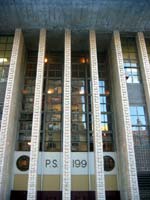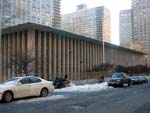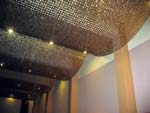
|

|
|
Home Site Search Contact Us Subscribe
|
|
|
Preservation Alert: P.S. 199, by Edward Durell Stone (1963) The public school on Manhattan's Upper West Side could be facing demolition if a developer takes up New York City's offer to sell the site. By Fred A. Bernstein March 22, 2013 Among the sites the New York City Department of Education has recently put up for sale is a 99,000-square-foot lot on 70th Street west of Broadway. Developers are being offered a chance to build a 600,000-square-foot apartment building on the 425-foot-wide parcel near Lincoln Center. But that would mean tearing down P.S. 199, a public school designed by Edward Durell Stone. In 2005, I visited the school and wrote the following account for Oculus magazine. Especially given the changes made to Stone's Huntington Hartford Museum on Columbus Circle and his General Motors Building on Fifth Avenue, the school deserves the attention of preservationists. To its credit, CBRE, in its offering on behalf of the city, notes that “there may be opposition to the demolition of the school.” Let’s hope!
----------------------------------------------------------------------------------------------------------
Edward Durell Stone
began his career as an “orthodox” modernist (his Museum of Modern Art, with Philip Goodwin, and his Conger Goodyear House, both from the 1930s, are
emblematic of his International Style roots). But Stone’s greatest success came
in mid-century with a series of classically-inspired buildings – from his
American Embassy in New Delhi (1954) to the Kennedy Center (completed in 1971).
Neither of his best-known Manhattan works, the General Motors Building, with its awkward plaza, or his Huntington Hartford Museum, with its unusual
“lollipop” details, is as successful as those strongly horizontal,
Parthenon-like buildings.
(Editor’s note: This article originally appeared in the Spring 2005 issue of Oculus magazine, the quarterly journal of the AIA New York Chapter; reprinted with permission.)
Fred Bernstein has degrees in architecture (from Princeton) and law (from NYU) and writes about both subjects.
Other columns by Bernstein on ArchNewsNow:
Mies built
the Farnsworth in spitting distance of the mighty Fox River, and the house is
paying a price for his hubris. An Open Letter to Susan Szenasy re: Frank Gehry I love and admire you. But I think you are wrong about Frank Gehry.
Eytan Kaufman Hudson World Bridge An architect's proposal to span the Hudson River would be a gathering place like no other.
Second Look: Pavilion and Colonnade Apartments by Mies van der Rohe, 1960 Newark, NJ: Current news about
"starchitects" designing high-rise housing in New York is at an
all-time high, but Mies did it across the Hudson River 46 years ago. Second Look: Tracey Towers by Paul Rudolph, 1972 Bronx, NY: How did Rudolph, a restless
and challenging architectural mind, end up doing subsidized housing in the Bronx? Op-Ed: The 2012 New York Olympics is lost. Long live the 2014 New York World's Fair.
Queens, NY: Its power undiminished after 40 years, a 20th
century cathedral to science is about to be rediscovered as a luminous addition
debuts this week. Beauty in Garbage: Naka Incineration Plant by Yoshio Taniguchi Hiroshima: An incineration plant is devised
as real-time science museum and tourist destination (complete with waterfront
park). Second Look: George Washington Bridge Bus Station / Pier Luigi Nervi, 1963 One of
Nervi's few completed projects outside Italy is a superb example of the poetry
he wrought from ferro-concrete. INSIGHT: The Might-Have-Been Memorial
|
(click on pictures to enlarge)  Fred A. Bernstein P.S. 199 entrance  Fred A. Bernstein West 70th Street façade  Fred A. Bernstein Auditorium ceiling with draped metal discs |
© 2013 ArchNewsNow.com